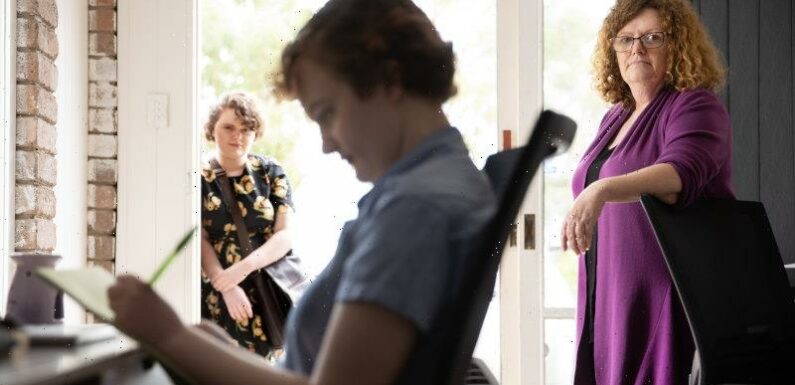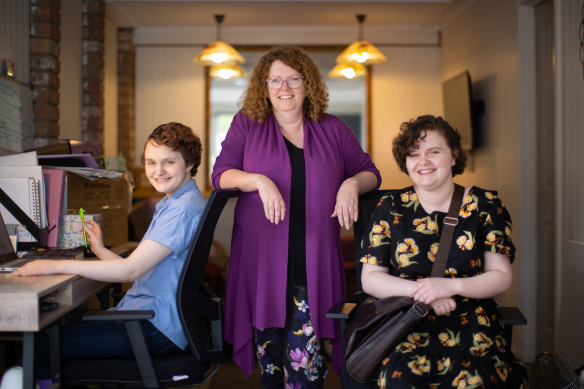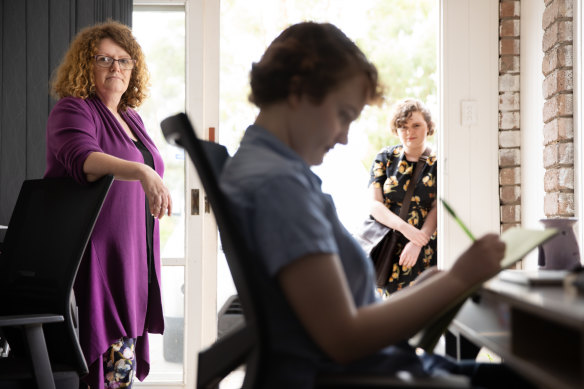
In numbers
- 11,825 – Number of Victoria students officially absent due to school refusal in 2021
- 50% – Growth in school refusal rate from 2018 and 2021
- 87.7% – Percentage of total school days attended by Victorian students from prep to year 10
- 86.5% – Percentage of total school days attended by Australian students from prep to year 10
- 20% – Growth in Virtual School Victoria enrolments since before the pandemic
The rate of school refusal in Victoria grew by 50 per cent in the three years to 2021, with almost 12,000 students in government schools – about 2 per cent – officially absent in the second year of the pandemic.
Authorities, educators, parent groups and experts said the issue was growing at an alarming rate and schools lacked the resources to overcome the worsening problem, which principals said had been supercharged by COVID-19.
Kylie Hughes with her daughters Ellen, 18, (left) and Georgia, 15, who are making use of alternative options to finish their schooling.Credit:Simon Schluter
Victorian data, contained in the government’s submission to a Senate inquiry on the national trend, reveals the rate of school refusal grew by 50 per cent in the three years between 2018 and 2021, with 11,825 students in state schools officially absent due to school refusal in 2021.
However, these figures almost certainly do not capture the full scale of the problem, the government said, with many school refusal cases officially recorded as medical or truancy-related absences, or not explained.
School refusal is distinct from truancy, in that it is driven by a high level of anxiety about attending school.
The submission says the problem is worst in secondary and specialist schools and in disadvantaged and regional areas. There are also high rates of refusal among year 6 and year 7 students, suggesting many children struggle with the transition to high school.
“Although the prevalence of school refusal as a reason given for student absence is low, it does show an increase across all years,” the submission said. “The factors that impact students experiencing school refusal and their families are broad and exist within and outside the school gate.”
Principals said increasing anxiety among students and the disruption of the pandemic had led the number of students experiencing school refusal to grow at an alarming rate.
Children’s charity Save the Children said Australia’s high rate of disengagement from education could be described as a national crisis, even before pandemic lockdowns.
“COVID-19 threatens to turn this significant existing problem into a generational rupture,” it told the inquiry.
One parent group said that school refusal is happening as early as year 3.
Catholic School Parents Australia told the inquiry that some parents had difficulty accessing specialist help such as psychologists, that schools often mistook a child’s anxiety-driven inability to attend school for truancy and that parents could not work owing to the needs of a school-refusing child at home.
Helen Barrett, principal of specialist school the Tombolo Academy, said many of the students who came to her school in Hampton had suffered long-term school refusal in a mainstream school system that is ill-equipped to respond.
“We took a new student who had only attended six days throughout the whole of year 7 just because he doesn’t quite fit into the mainstream setting,” Barrett said.
Parents are often as broken and traumatised as the students by the time they enrol their child in the small alternative school, she said.
“The parents are often in tears when they come here because it’s like we are their last chance because they’ve tried lots of different schools and the schools have said we can’t help you.”
But the Melbourne Graduate School of Education said some schools let disengaged students slip through the net because they might drag down their academic scores.
“There is little incentive for mainstream schools in today’s narrow and competitive educational environment to attempt to take in and rehabilitate detached and disengaged young people because the consequences appear too negative,” the school’s Professor Jim Watterston and Megan O’Connell said.
If your child is showing signs of school reluctance or refusal:
Source: Parenting Strategies
“Thus, high-needs students often become collateral damage in the quest for higher academic performance and enhanced reputation.”
Federal Education Minister Jason Clare said he wanted to improve Australia’s worrying school refusal rates.
“That’s why I have put this on the agenda for the next education ministers’ meeting this month,” he said.
The Australian Secondary Principals’ Association said “without a doubt” there had been an increase in the number of young people who cannot attend school regularly and that the trend has been supercharged by COVID-19.
“Over the years we have seen a significant trend in the number of students unable to attend school due to high levels of anxiety and mental health issues,” the association said.
Schools also have not had the resources or the time to recover from the pandemic, or to invest in reflecting on lessons learned, and are struggling to resource the interventions now required to manage school refusal, it said.
Hurstbridge mother Kylie Hughes’ daughters are both making use of alternative options to finish their schooling.
Her 15-year-old daughter Georgia swapped to an alternative school, Indie College, this year after starting to refuse school.
Kylie Hughes with her daughters Ellen (centre), who is completing VCE over two years through virtual school, and Georgia, who has switched to an alternative school.Credit:Simon Schluter
Georgia, who has autism and ADD, said from a sensory and focus perspective, mainstream school was not right for her.
“It definitely got much, much worse during online classes during COVID … then everything went back to being in person and that I think hit me pretty hard,” she said.
She said her anxiety about going to school manifested in stomach aches and feeling too tired or unwell.
Hughes said as a parent she often felt unheard and that it was important for parents and students to keep an open mind about their options.
“I think that intervention, particularly in the public system, comes too late, particularly for kids who are disengaged. There’s very little support available for parents, the messaging we kept getting was, just keep sending her,” she said.
“There were so many days that that was really hard because she was clearly distressed and we were distressed by her distress. I think particularly for children who have additional learning needs, the early support is so important.”
She said: “Thirty hours a week is a lot of time to be unhappy.”
Older daughter Ellen, who has heart and lung conditions as well as autism and ADHD, is completing VCE over two years through virtual school. The 18-year-old said alternative school options were of “vital importance”.
“It’s excluding a very large portion of the population and expecting them to fit into a model that isn’t for them,” she said.
Data from the Australian Curriculum Assessment and Reporting Authority shows Victoria has the highest attendance rate in the country, with students from prep to year 10 attending 87.7 per cent of all school days, compared with the national average of 86.5 per cent.
In Victoria, school refusal was given as the reason for student absence for 1.8 per cent of cases in government schools in 2021, up from 1.2 per cent in the three years prior.
Victorian opposition education spokesman Matthew Bach argued in an opinion piece for The Age this week that: “Government is not solely responsible for solving this problem. We also have to be clear on our responsibility as parents, and that is to show tough love and get our children to school.”
But clinical psychologist and Deakin University associate professor Glenn Melvin said it was an oversimplification to say tough love was a solution.
“We need to look to empower parents rather than blame them for their approach. This is an issue that will bring very capable parents to a very stressed state.”
Findings from the Senate inquiry are due to be reported next month.
If you or someone you know needs support you can contact Headspace or Beyond Blue on 1300 22 4636.
The Morning Edition newsletter is our guide to the day’s most important and interesting stories, analysis and insights. Sign up here.
Most Viewed in National
From our partners
Source: Read Full Article

